 By Pepper Parr By Pepper Parr
October 7th, 2024
BURLINGTON, ON
First of a week long series on the changes taking place in print media and the challenge keeping the public informed.
This is National newspaper week; an occasion to look at the challenges the news business faces.
That daily newspaper that was read in most households in the evening or the paper that was delivered in the morning before Dad left for work are things of the past.
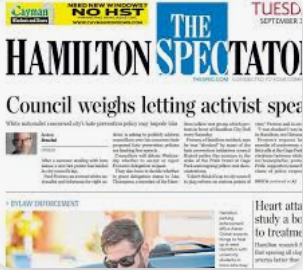 Once the largest newspaper in western GTA – the Spectator struggles to stay alive. We no longer have daily newspapers, or weekly newspaper that tell us what is going on in our communities, provinces, the rest of the country or the world.
There are some daily newspaper being published. The Hamilton Spectator comes out six days a week but it is not the powerful local daily it once was.
Except for a small number of daily newspapers that are national in scope – the New York Times, the Washington Post or the Los Angeles Times – include some of the financial press like the Wall Street Journal or the Financial Times and that is what we have. There are exceptions but they are few and far between.
Those publications have reasonably robust advertising bases that fund the operation; everyone else was taken out by services based on the internet.
Craig’s List and Kajiji killed Classified Advertising; a service that drew in millions in revenue with little in the way of editorial expense other than taking down the information and setting it all up under the dozens of classifications. It was a brilliant idea that has been with us for centuries in different forms.
 Classified advertising was phenomenally successful Newspaper revenue from classifieds advertisements decreased continually as internet classifieds grew. Classified advertising at some of the larger newspaper chains dropped by 14% to 20% in 2007, while traffic to classified sites grew by 23%.
This was the beginning of the end for print newspapers. It took an additional decade and a half for the business side of newspapers to realize that they were in serious trouble – by that time it was too late.
In the past year the Toronto Star pulled the plug on their Metroland unit that published close to 50 weekly newspapers in the province.
 Soon after Kajiji was created others created versions of online advertising that included photographs – it was classified with colour and all on line. Without a financial base print was dead – going on line was the answer but it took time for the larger media companies to figure that out.
Newspaper could tell a story – they had sections that reported on business – the Globe and Mail Report on Business being the most successful. Ironic that while very good at reporting news they were not able to see how what they were reporting was going to impact them. They weren’t able to see the fundamental change that was taking place.
An interesting example of the newspaper that saw the change coming and found a way to change their business model.
The Toronto Star and LaPresse, the largest French newspaper in Quebec, formed a joint venture with the Toronto Star to create a digital version of the newspaper and publish as online newspapers.
 Going totally digital worked for Montreal’s French language newspaper. It worked for LaPresse – the Star was never able to convince their readers that online was going to be the way you got your news.
In 2016, a few years after the launch of La Presse+, print was restricted to Saturdays and shortly thereafter, on 31 December 2017, the last newspaper was printed.
Publisher Guy Crevier says the paper will become the world’s first major daily to go completely digital on weekdays as it responds to a permanent shift in advertising spending.
Guy Crevier, publisher of LaPresse, pointed out that the North American newspaper sector had lost 63 per cent of its revenues — or $29 billion — over the past decade. “There is nobody who can survive in an environment like that.
The Toronto Star was losing far too much money – the family trust that held a majority of the voting shares accepted an offer to sell the newspaper.
 Nicole MacIntyre – Toronto Star editor The newspaper was acquired by NordStar Capital on May 26, 2020, after the board of Torstar voted to sell the company to the investment firm for CA$52 million—making Torstar a privately held company.
The two businessmen, Jordan Bitove and Paul Rivett bought the newspaper along with the regional newspapers and the chain of weeklies, found that they didn’t share the same vision for the Toronto Star. Bitove bought out Rivett. In July the Star appointed Nicole MacIntyre as editor.

By Staff
BURLINGTON, ON March 14, 2011 – David Vollick got asked to help at a church event awhile ago – they needed someone with a loud voice to let people know about the different events that were taking place one Christmas Season. They dressed him up a bit and gave him a bell to ring and that planted the deed of an idea in Dave’s mind that resulted in his appearing before a city council committee to suggest that Burlington might get itself a Town Crier.
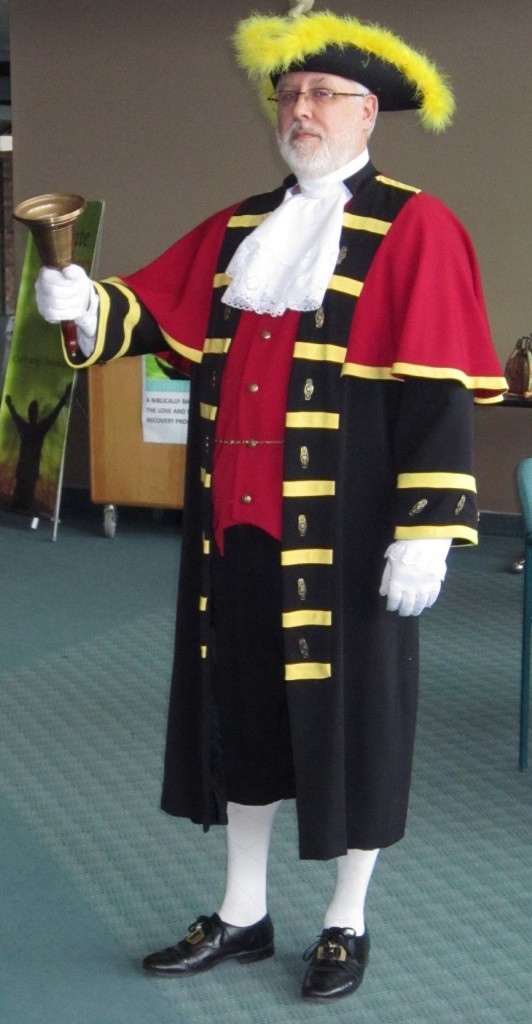 Costs $50. to clean and press the uniform – but he is pretty isn’t he. David Vollick as a Town Crier. Council kind of liked the idea and sent it off to staff to consider all the implications and sometime later this year the city will probably have a Town Crier of its very own. Vollick wasn’t asking Council to pay him to do the job but he did point at that the people getting the benefit of the Crier usually pay a small stipend to cover the cost of cleaning the elaborate uniform they wear.. As Dave pointed out ”it costs $50. to have this uniform cleaned and pressed.”
His wife Barbara often joins him at any events he works. What council heard was that Crier could read out the public declarations that are made by the Mayor. Girl Guide Month or Small Business Week – the range is immense. There could be a proclamation made on Canada Day.
The first documented use of a Town Crier was in1066, after the Norman Invasion of England. Criers were regularly used after that by the ruling King or Queen to inform all the citizens of their orders and decrees. To this day old English law still protects Criers from being Hindered or Heckled whilst carrying out their duties.
The term “Posting A Notice” comes from the act of the Town Crier attaching the notice or Proclamation he had read to the door post of the local Inn or Tavern.
Citizens of the towns relied on the crier for the information, be it good or bad news. Criers were not always men. Many Town Criers were women. Bells were not the only attention getting device. In Holland a Gong was the instrument of choice for many, and in France they used a Drum, or a Hunting Horn.
Criers where often old military veterans who could read and write but who had fallen on hard times. The position of Town Crier gave them employment and a pension. The position of Town Crier has often been passed from one generation to the next.
Council directed the City Manager to investigate the idea of establishing an Official Town Crier for Burlington, looking into the costs and report back to the Community Services committee by April 20.
 David Vollick ably assisted by his wife Barbara. The intention was to hold a contest for a crier if the city manager could find a benefit for the city. Tourism Burlington was reported to like the idea and Vollick could see the Crier being used for store openings and other events that wanted to draw public attention.
We just might see someone at City Hall reading out a Proclamation on Canada Day while the cyclists zoom by.
[retweet]

 By Pepper Parr By Pepper Parr
January 3rd, 2024
BURLINGTON, ON
There wasn’t much in the way of notice.
The last print edition of the Burlington Post was printed on September 15th. The public got the news a day before. The Post is one of 70 local newspapers that are part of Metroland.
What does all this mean to Burlington?
 John Best, a colleague who publishes the Bay Observer put it very well when he said: “Locally, the biggest danger is in a community like Burlington, where on a good day there would have been one or two people at the media table at City Council or Board of Education meetings—now maybe none. John Best, a colleague who publishes the Bay Observer put it very well when he said: “Locally, the biggest danger is in a community like Burlington, where on a good day there would have been one or two people at the media table at City Council or Board of Education meetings—now maybe none.
“Burlington Council with only seven members is already more or less devoid of any real debate, its seven members apparently in broad agreement on almost everything, or if they don’t, they hash it out somewhere else. The small size of the council is a factor that makes it easier to keep members in line, and the lack of media scrutiny outside of online disruptors like the Burlington Gazette have led to a country-club atmosphere. This is a council that put its heads together in 2022 and decided to keep the $100 million cost of the Bateman Community Centre Project a secret until after they were all safely re-elected. Media scrutiny has diminished in Burlington right at the time when a whole lot more is needed.”
Loosing a print media is significant and a clear understanding of just what happened to the Post and the other Metroland newspapers matters
Nordstar Capital LP owns the Toronto Star which is struggling. The Toronto Star owned Metroland. “Metroland was losing money; working furiously to find a solution but realized they were at a point where they simply couldn’t pay their expenses. Torstar chief executive officer Neil Oliver said at a creditor meeting held in November. That “Metroland is not out of the woods with the proposal, we believe it gives the remaining team and properties the opportunity to be viable for the long term.”
 Metroland cited the challenging economic environment for newspapers – particularly the steep decline in print advertising revenue – for its financial troubles. The company’s papers have faced a “sizable loss of readership” and revenue has fallen more than 10 per cent each year for the past three years, according to Grant Thornton, an accounting firm. Metroland cited the challenging economic environment for newspapers – particularly the steep decline in print advertising revenue – for its financial troubles. The company’s papers have faced a “sizable loss of readership” and revenue has fallen more than 10 per cent each year for the past three years, according to Grant Thornton, an accounting firm.
Metroland said in mid-September that it planned to make a proposal pursuant to Canada’s Bankruptcy and Insolvency Act, and it followed up in mid-October with the plan.
In his report to creditors, Grant Thornton trustee Jonathan Krieger recommends a “Yes” for the vote scheduled for Tuesday, which would give unsecured creditors 13 cents on the dollar for their claims. Key to this analysis, of course, is just how much Metroland’s assets are worth.
 The news business has changed. Among those creditors were the news reporters who no longer have jobs.
“There was no discernible enterprise value for a business that has lost $10-million in the past year alone” adding that Metroland “held numerous M&A discussions with prospective buyers over the past year and could not procure a successful cash bid for any of the newspapers,” he said. The $20-million in equity stakes are undisclosed because they are “subject to confidentiality provisions.”
However, unlike other corporate reorganizations where the stockholders get wiped out in order to pay creditors, Torstar will emerge from this process maintaining its 100-per-cent ownership of Metroland, with all of its assets.
It would not be incorrect to say that there are some shady issues surrounding how the Star managed to dump the Metroland employees, offer them pennies on the dollar and try to get some federal money for them.
If the creditors had said No to the proposal that was before them they would have been given five cents on the dollar, not 13 but Metroland would have been bankrupt – dead. But because the offer was accepted by the creditors Metroland is in receivership which means it is still operating.
The plan was recommended by an independent trustee employed by Grant Thornton, charged with operating in the interest of all the stakeholders in the matter. Some observers felt the trustee’s report was thin on details to make creditors wonder whether they have enough information to make an informed decision.
Creditors of insolvent newspaper chain Metroland Media Group Ltd. voted to approve a proposal on Monday that would see the company pay pennies on the dollar to restructure its debt and avoid bankruptcy.
Metroland sought creditor protection on Sept. 15 with liabilities totalling more than $78-million. The publisher laid off 605 employees, nearly two-thirds of its work force, without paying severance or termination pay, while other employees who took voluntary buyout packages earlier this year had their salary continuance payments cut off.
A restructuring proposal like the one filed by Metroland allows a troubled company to address its debt and avoid a bankruptcy filing. Had creditors voted against Metroland’s proposal, the company would have been deemed bankrupt under the Bankruptcy and Insolvency Act.
Accepting the proposal meant that Metroland was kept alive while the 600+ employees looked at empty wallets.
The amount to be paid to creditors is not finalized. Metroland intends to apply to the federal government’s Wage Earner Protection Program, (WEPP) which offers payment to former employees stemming from a bankruptcy or receivership.
If WEPP is approved, former employees will receive 17 cents on the dollar for the balance of their claims, in addition to other payments. Other unsecured creditors would receive the same repayment percentage.
Lawyers for Metroland scheduled a court date to seek WEPP in late November, but the Department of Justice indicated it would oppose the motion. Metroland is still an operating company, and not in bankruptcy. The company then arranged to have a receiver appointed over its inventory, which could aid in its WEPP application.
“We believe that the likelihood of WEPP being eligible for this company is likely enhanced by virtue of that receivership,” Grant Thornton partner Jonathan Krieger said at the creditor meeting on Monday.
What does this mean to the communities across the province that relied on their local newspaper for news on current events..
Burlington had to decide recently where it would place notices they are required to publish under both the Municipal Act and the Planning Act.
Burlington is currently served by four online newspapers. The Gazette, which was the first online paper to be recognized by what was then the Ontario Press Council in 2010. The Post has become an online newspaper, the Bay Observer serves the Burlington market as does Burlington Today, a recent addition to the Burlington market.
The ceasing of the print publication of The Burlington Post has multi-faceted impacts on how the City provides public notice.
Whereas the Municipal Act, 2001 allows municipalities for more flexibility, other legislation is very specific as to the manner in which notice is given.
Staff have undertaken a review of the City’s Public Notice Policy and are seeking to make amendments where publication in a newspaper is not a prescribed requirement under the Municipal Act, 2001. Amendments to the Public Notice Policy are based on the findings summarized below:

Based on the above definition and the definition included in the policy, The Hamilton Spectator has been determined as the paper of record for the City of Burlington in the absence of a local newspaper such as The Burlington Post. The Hamilton Spectator is a daily newspaper with 4,673 subscribers in Burlington compared to The Toronto Star at 1,152 subscribers.
The Public Notice Policy provides minimum notice standards and encourages the public notice authors to consult with Corporate Communications & Engagement staff to ensure all appropriate tactics are used when providing notice to the public. The City has a dedicated News and Notices section with 1,065 current subscribers, where all City notices are posted in one centralized location.
By removing the requirement for printed media notices, where not statutorily required, the policy provides more flexibility while ensuring legislative requirements are met. In instances where newspaper notices are required, such as the Publication of Financial Statements, election notices, or notices required under other legislation including the Planning Act, the City will use The Hamilton Spectator based on the general circulation requirement, in addition to notices posted to the City’s website and digital publications. Many other municipalities have moved towards the publication of notices on their websites either exclusively or with a hybrid approach given the changing media landscape.
What this really amounts to is the city walking away from the concept that they really want to keep the public informed. Transparency and accountability took another punch in the head.
Financial Matters:
Costs will be incurred depending on the type and frequency of notice. If a legislative requirement to post notice in print media exists, the associated cost is unavoidable. Below is a cost comparison for comparable ads in The Hamilton Spectator versus The Burlington Post. These are the preferred rates for the City as provided by Communications staff. This price list is not extensive and meant to show cost differences.
| Approximate size of ad |
Burlington Post |
The Hamilton Spectator |
| 5” x 5” |
$372.50 |
$895 |
| 10” x 5” |
$696 |
$1,650 |
Whereas the cost to post notices in the Hamilton Spectator are nearly triple than The Burlington Post, the frequency of the required notices under the Municipal Act, 2001 can be expected to decrease. In some instances of notices required under the Planning Act, those costs are forwarded onto the applicants.
Total Financial Impact
On average, there have been 250 ads placed throughout the year, but that number does fluctuate. In 2022 the print costs totalled $131,103 with the Burlington Post. Staff will monitor the increased advertising costs closely in 2024 and mitigate the financial impact where possible. Should an increase to the City’s advertising budget be required, staff will identify the need as part of the 2025 Financial needs and Multi-year Forecast for the Mayor to consider for inclusion in the 2025 Proposed Budget.

 By Pepper Parr By Pepper Parr
January 27th, 2024
BURLINGTON, ON
You got here when you clicked on the Essential Reading graphic. Let me make the decision you made to click worthwhile.
When people ask me what the Gazette is, I tell them it is Essential Reading for people who live in Burlington and want to know what’s going on and what your City Council is doing. We make that point when we say: Informed people can make informed decisions.
Ensuring that the people you elected are kept transparent and accountable happens when there is fact based media, supported by informed opinion keeping an eye on them.
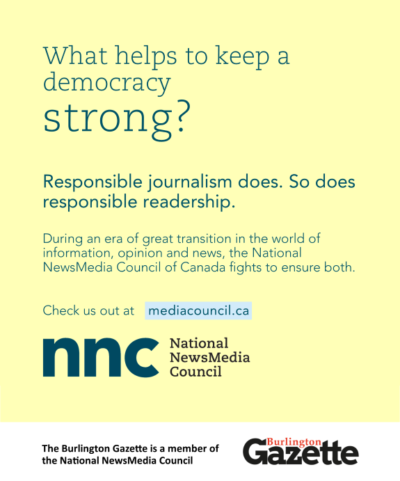 Who is out there helping you understand what is happening?. Recall the people who spoke bluntly about the tax increase the city put in place? You would have read about their delegations in the Gazette Who is out there helping you understand what is happening?. Recall the people who spoke bluntly about the tax increase the city put in place? You would have read about their delegations in the Gazette
There is a major change in the patio program the city has put in place; what started out as three patios has grown to more than 20 that will pop up on the streets of the city. They are changing the city streetscape with little comment from the public.
The Gazette has been publishing for 12 years. We are members of the National Newsmedia Council; an organization we are accountable to.
We are experimenting with different ways for readers to interact with the news and opinion we publish because that is what Essential Reading is all about.

 By Pepper Parr By Pepper Parr
December 7th, 2021
BURLINGTON, ON
The City Hall communications people put out a media release on the taxi situation in the city.
With the Public Vehicle By-law amendments providing a temporary solution to replace lost taxi service, the City of Burlington is sharing that Blue Line Taxi company has been issued a new taxi licence. Blue Line Taxi will start to service Burlington residents today. To book taxi service, Burlington residents can call Blue Line Taxi by phone (905) 525-0000 or book online at 525blue.com.
 905-525-0000 will bring one of these cabs to your door The by-law that governs the issuance of new taxi licences was written to meet the needs of the taxi business model that existed in 2009. To allow new business to enter the Burlington transportation market, City staff recommended interim by-law amendments. These amendments provide flexibility in the application process to meet the demands of current business models.
Quick Facts
- Burlington’s main taxi service provider Burlington Taxi ceased operation on Nov.26, 2021
- At the Nov. 30, 2021 Special Council meeting, City Council approved amending the Public Vehicle By-law to allow exemptions to existing licensing requirements so other taxi services could apply to provide service for Burlington residents
- The by-law amendments allowed applications for new taxi owner licences/plates to open on Dec. 2, 2021 until all spaces are full
- The by-law amendments are intended to provide a temporary solution. City staff are aiming to undertake a comprehensive review and consultation and have a new by-law created prior to December 31, 2023.
- Further review is required not only to determine appropriate taxi licensing requirements, but to investigate the ‘rideshare’ businesses and options for regulating that market.
 Mayor Marianne Meed Ward Mayor Marianne Meed Ward said: “I know we all welcome the news that taxi service can resume in our community as early as today, and in time for the holidays. I want to thank the successful applicant for coming forward, and I’m grateful to City staff and my Council colleagues for working quickly to find a temporary solution to restore taxi service in Burlington immediately. I also thank staff for their ongoing efforts to bring forward a permanent solution to this issue. As well, thank you to Burlington Taxi for their 53 years of dedicated service to our community.”
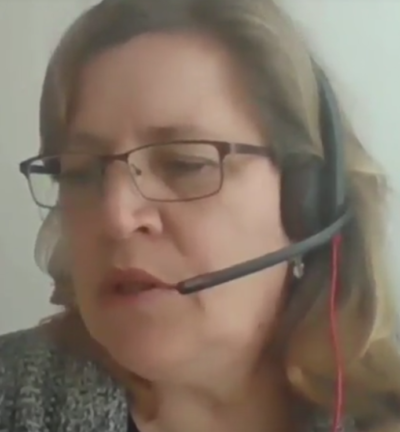 Ward 4 Councillor Shawna Stolte Ward 4 Councillor Shawna Stolte said: “As we learned earlier this morning, amendments to our Vehicle/Taxi Bylaw will allow us to welcome 13 new taxi vehicles onto to our streets as of today, Tuesday, December 7, 2021. Staff are open and eager to review additional licenses to increase this number of available taxi vehicles as multiple companies in the taxi industry continue to come forward with applications. It was unfortunate that these changes and amendments were not considered before the closure of Burlington Taxi as this could have avoided the subsequent transportation crisis for many Burlington residents, but I am relieved that an expedient way forward was sought by staff and I look forward to the renewed commitment to this valuable mode of transportation for Burlington residents in the future.”
There is some “shame on you” to be spread around on this one.
Related new stories:
Scott Wallace Talks Back
Burlington Taxi announces the need to close

 By Staff By Staff
August 20th, 2019
BURLINGTON, ON
The Halton Regional Police Service found that working with its media made it possible for residents to be reunited with their stolen property.
On August 16, 2019, a Hamilton resident learned about the recovery results that came out of the arrest the Regional police made on July 4th.
 Much of a currency collection was recovered by police. Investigators in Burlington – 3 District Criminal Investigations Bureau were contacted and later reunited the victim with over 95% of the recovered stolen property.
Investigators are currently liaising with Hamilton Police and further charges are pending.
The remaining property can be seen by clicking here:
Anyone who may have additional information concerning this investigation is asked to contact Detective Constable Jacques Brunelle of the 3 District Criminal Investigations Bureau at 905-825-4747 ext. 2334 or the 3 District Criminal Investigations Bureau general line at 905-825-4747 ext. 2316.
Tips can also be submitted to Crime Stoppers “See Something? Hear Something? Know Something? Contact Crime Stoppers” at 1-800-222-8477 (TIPS), or through the web at www.haltoncrimestoppers.ca.
In the original media release the Halton Regional Police Service advised the public that they had arrested a suspect attempting to gain entry into the Kings Carwash located at 1448 Grahams Lane in Burlington. At the time of the arrest a large quantity of jewelry believed to be stolen was recovered and remains unaccounted for.
Bradley MARK (37) of no fixed address was charged with
• Break and Enter with intent
• Possession of Break in instruments
• Possession of property obtained by Crime
• Fail to comply with probation order
He was held pending a bail hearing.

The Burlington Gazette is a member of the National Newsmedia Council.
When the Gazette was covering a meeting of the Halton District School Board we made an error and attributed a statement to one of the trustees from Milton when it was made by one of the trustees from Oakville. The two sit side by side during school board meetings. We corrected the error but not to the complete satisfaction of the trustee. The NNC requires the Gazette to publish their report on how they respond to a complaint. That report is set out below.
April 3 2018
The National NewsMedia Council has upheld a complaint about accuracy and errors correction in the Burlington Gazette.
The March 22 2018 article reported on a Halton District School Board meeting, where part of the discussion was about a new administration building.
The complainant, Kim Graves, stated that two statements in the article were untrue.
The first cited inaccuracy was that “The Oakville and Milton trustees didn’t like the distance they would have to drive to get to Board meetings if they continued to be held in Burlington”. No trustees were named in the article but Graves, a trustee from Milton, objected that she did not make that statement.
Graves said the second untrue statement is that trustees “are queasy” about discussing the new administration centre. She said the statement implied all trustees are queasy, and is untrue because she is not queasy about having the discussion.
In its response, The Burlington Gazette said it did not refuse to make a correction, but that it would review the three-hour video of the meeting web cast.
Subsequently, the news outlet published a correction stating that in an “earlier version of this news story we said that Milton trustee Kim Graves had complained about the distance she had to drive to get to school board meetings” and that it was the trustee beside her who made the comment.
That correction also stated “we said ‘… they were a little queasy about having this matter on the table…’. It would have been more correct to say that some were queasy.”
The complainant objected to the first part of the correction as inaccurate. She noted the original article did not name her as making a statement, but did incorrectly imply she made a statement.
Based on the above, Council upheld the complaint about an inaccurate statement. It also upheld the complaint about the correction, because it incorrectly conveyed the original statement and drew unwarranted attention to the complainant. It is worth noting that the original statement implied six trustees were of the same view, but the correction admitted to misattributing a comment to just one.
The complainant also raised questions about the news media’s approach to making a correction. While it is reasonable for the journalist to double check the audio video recording, and to ask for a quote on that or another issue, it is also the prerogative of the trustee or any other interviewee to decline to comment. A correction should not be contingent on providing a further quote.
The news outlet defended its request for further quotes, and stated it “wanted to see a statement that was clearer” than the complainant’s earlier comments.
As a general comment, Council noted that tension between the media and institutions is normal and part of the accountability dynamic of a healthy democracy. However, journalistic standards of accuracy, opportunity to respond, attribution, citing reliable sources, and willingness to make prompt and meaningful corrections are essential in a reputable media. Similarly, government and institutions have a role in allowing media access to information, and those in public office must expect a higher degree of scrutiny and less privacy than those individuals in private life.

March 10th, 2018
The Burlington Gazette has been a member of the National NewsMedia Council for five years. We became members when it was the Ontario Press Council.
The Council is in place to ensure generally accepted journalistic practices are followed.
We disagree with the decision the Council made in their March 9th founding but as members we are obliged to publish their reports.
The Council decision is set out below.

March 9, 2018 – For immediate release
2018-06 Ako-Adjei vs Burlington Gazette
The complainant, Kwabe Ako-Adjei, said the December 15 2017 Burlington Gazette article, “Major
organizational moves by the city manager seem to be out of focus”, contained inaccurate information.
He cited specific examples including errors in the reporting of a department re-organization and a staff change. He argued the errors could have been avoided with an email to city staff for verification. The complainant emailed the news organization a list of five points it felt were inaccurate and asked for a correction of the article.
The complainant also objected to the manner in which corrections were done, which was to append portions of the complainant’s email, in a different font colour, to the top of the article.
Subsequently, the complainant provided an example of an article that was critical of a city manager and published without giving the staffer opportunity to respond.
The Burlington Gazette responded by contacting NNC staff for clarification about the complaints. Staff stated a response should speak to the method of correction, and the reasons to seek verification of the information or not.
After three weeks with no further response from the news organization, NNC staff issued a warning that a recommendation would go ahead based on the information at hand.
At that point, the news organization responded with information detailing conflicts with municipal officials and expressing the opinion that city hall was trying to ‘shut down’ the Burlington Gazette.
The response also noted the publisher previously met with NNC staff for a discussion on journalistic standards about separating news from opinion in articles.
Finally, the Burlington Gazette suggested the complaint should be set aside until the publisher’s legal conflict with the city is settled.
On reviewing the complaint and related materials, the articles in question, and the news organization’s response, Council upheld the complaint about accuracy. The complainant, who is a city staff member, provided information that pointed to reporting errors. The publisher acknowledged one error and did not contradict others, nor did he defend his original material.
The complainant invited the publisher to call city hall to verify facts. There is no evidence that the publisher responded to those invitations. In contrast, the publisher stated that the city manager is trying to shut down the news organization.
In reviewing the article in question, the news organization failed to follow generally accepted journalistic practice for making corrections, which is to label the correction, state the correct material, and make clear what material it replaces. Council upheld this portion of the complaint.
Council found repeated instances in the submitted material where news and opinion were not adequately separated. The article in question was labeled both ‘News’ and ‘News Analysis’, which is not helpful in letting the reader know if news or opinion was being presented.
It was also evident that the news organization made liberal use of reported information without seeking verification, with qualifiers such as “according to people who were in the room”, and suppositions such as “appeared to have looked at Tanner in a manner that was uncomfortable to her”. Widely accepted journalistic standards require verification of fact, naming sources of verification when appropriate, and giving those named an opportunity to respond.
In light of the reasons stated, the NNC upholds the complaint.”

 By Pepper Parr By Pepper Parr
October 16th, 2017
BURLINGTON, ON
She was in what she calls her “happy place” sitting quietly with her library card in her hand getting ready to speak.
 Eleanor McMahon, the Minister of Tourism, Culture and Sport was kicking off Public Library Week and announcing improvements to digital services at 307 libraries and library organizations across the province. Eleanor McMahon, the Minister of Tourism, Culture and Sport was kicking off Public Library Week and announcing improvements to digital services at 307 libraries and library organizations across the province.
She spoke too of the valuable role that libraries play in Ontario communities.
Shelagh Paterson, Executive Director, Ontario Library Association said that libraries serve as the greatest equalizer for access to information across our communities.
The Library Digital Services fund provides resources for people in the community to use at its Ideaworks Studio, including a new 3D printer, digital embroidery machine and new digital media software. People will be able to enjoy these specialized technologies for their own interests and to help with projects and schoolwork.
 McMahon told the small audience that Ontario is increasing access to technology, digital services and training opportunities at public libraries in towns, cities and Indigenous communities across the province. Funding is helping libraries offer more technology in their communities, such as wireless internet connections, new computers, and e-books, as well as classes on topics like social media and computer literacy. McMahon told the small audience that Ontario is increasing access to technology, digital services and training opportunities at public libraries in towns, cities and Indigenous communities across the province. Funding is helping libraries offer more technology in their communities, such as wireless internet connections, new computers, and e-books, as well as classes on topics like social media and computer literacy.
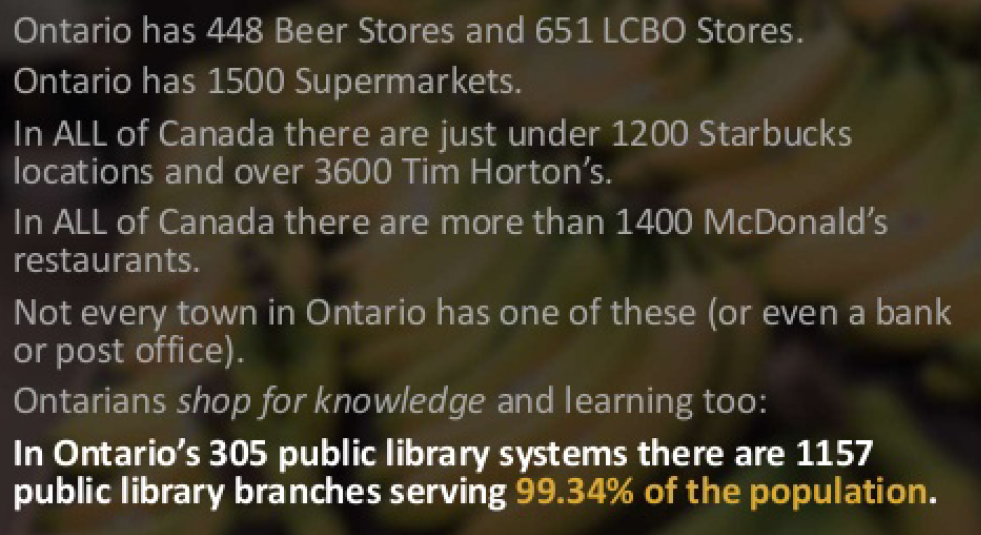 Ontario is investing $3 million through the Improving Library Digital Services fund to support up to 307 libraries and library organizations across the province. This includes $1 million for rural, remote and First Nation public libraries through 2017 Budget Talks. Burlington Public Library is receiving $25,000 from this fund. Ontario is investing $3 million through the Improving Library Digital Services fund to support up to 307 libraries and library organizations across the province. This includes $1 million for rural, remote and First Nation public libraries through 2017 Budget Talks. Burlington Public Library is receiving $25,000 from this fund.
This investment builds on a commitment in Ontario’s Culture Strategy to support Ontario’s public and First Nation libraries as essential spaces for people to access cultural experiences, technology and community life.
Library week runs from October 15-21; the first took place in 1985

 For immediate release For immediate release
September 14, 2017
BURLINGTON, ON
The National NewsMedia Council has upheld a complaint that the Burlington Gazette breached journalistic standards in printing a correction that was inaccurate and did not provide opportunity to respond to an allegation.
Complainant Denise Davy stated that a May 23 2017 article, “The Gazette erred – Director of Education Miller did not meet with MPP McMahon”, provided no evidence to support a statement in the correction that false information was “knowingly given”, and allowed no opportunity to respond to that allegation.
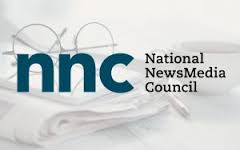 The complainant stated that she was called by the Burlington Gazette for information related to a school closing, and in that conversation she stated the director of education met with the MPP about a school closing issue. The news media organization reported her information. Later the same day it ran a correction stating the meeting in question had not occurred, and that “false” information was knowingly given. The complainant alleged the inaccurate correction and accusation impugned her reputation as a writer. She provided wording for an amended correction. The complainant stated that she was called by the Burlington Gazette for information related to a school closing, and in that conversation she stated the director of education met with the MPP about a school closing issue. The news media organization reported her information. Later the same day it ran a correction stating the meeting in question had not occurred, and that “false” information was knowingly given. The complainant alleged the inaccurate correction and accusation impugned her reputation as a writer. She provided wording for an amended correction.
In its response, the news media organization said the interview with the complainant was interrupted and not resumed. It justified the decision to rely on a single source for the original story by referring to the established working relationship with the complainant. The correction article reported the director of education stated the meeting format was by phone rather than in person. There was no evidence of effort to verify either source in either instance.
The paper’s correction apologized to the director of education and the MPP, and faulted the complainant for the error. The news media organization denied the correction impugned the complainant’s character as it did not specifically identify her.
Reviewing the articles, Council found the news media organization’s view that it did not specifically identify the complainant was disingenuous in view of reporting her gender, occupation and position on the controversy. As well, the complainant was named and her photo was included in the original article, which remained easily searchable on the news media organization’s website.
No evidence was provided to support the statement in the correction article that the information given by the complainant was known to be false. The unsupported statement in question is an allegation of intentional error or shortcoming, with no indication there was opportunity to reply to the accusation. Council found the correction breached journalistic standards of accuracy and accountability by making a serious allegation and by failing to provide opportunity to respond to the allegation.
In upholding the complaint, Council noted it is commendable that the news media organization corrected information about whether a high-level meeting on a contentious community issue was held in person or by telephone. However, no evidence was offered to support the allegation that the flawed information was known to be false.
Best journalistic practice is to avoid single-source material. Adherence to that practice may have avoided the problem in the first place. In this case, the error was in the format rather than in the fact of the meeting. Because there was a breach of best journalistic practice, a simple clarification noting a reporting error would have been appropriate.
The complainant specified the wording of a correction. Because the NNC supports the prerogative of news media to determine their own content, it will not dictate the wording of a correction or compel a member to publish an apology. The NNC does expect member news organizations to publish or post NNC decisions in the case of an upheld complaint.
The NNC’s business is to consider complaints about journalistic standards. It declines to comment on the allegation that the complainant’s character was impugned.
The Gazette and the Newsmedia Council
Reach the National Newsmedia Council
The Gazette wished to add that “We have been judged to have erred and accept the wisdom of our peers.”

 By Pepper Parr By Pepper Parr
September 9th, 2017
BURLINGTON, ON
The Gazette is a member of the National NewsMedia Council
We became members when the organization it was known as the Ontario Press Council – at that time we were one of the earlier online newspaper accepted into member unanimously by the Board of Directors at that time.
We pay an annual fee to be members – it isn’t cheap.
The National NewsMedia Council (NNC) does not impose its own code of practice. Instead, it expects members to adhere to their own or some generally-accepted code of journalistic standards, practice and ethics.
 In considering a complaint, the NNC has regard for a cascading set of criteria that includes the news organization’s own code of conduct; generally-accepted national and regional journalistic standards; standards such as those of the Canadian Press and the Canadian Association of Journalists; such legal or ethical guidelines as appropriate; and any other considerations deemed valid by the Board. In considering a complaint, the NNC has regard for a cascading set of criteria that includes the news organization’s own code of conduct; generally-accepted national and regional journalistic standards; standards such as those of the Canadian Press and the Canadian Association of Journalists; such legal or ethical guidelines as appropriate; and any other considerations deemed valid by the Board.
The NNC promotes media ethics and responsible journalism through our mediation services, pre-publication advising, and outreach.
One of the prime purposes of the NNC is the provision of a place people can go to and air complaints they have about how media has treated them.
This is a valuable public service that is needed – media have to be held to account.
The NNC works diligently to get both sides of the story and they issue a statement that can be either:
An upheld complaint.
Dismissed complaints.
Dismissed with reservations.
Resolved due to corrective action taken.
As NNC members the Gazette is expected to publish any decision made to the Council.
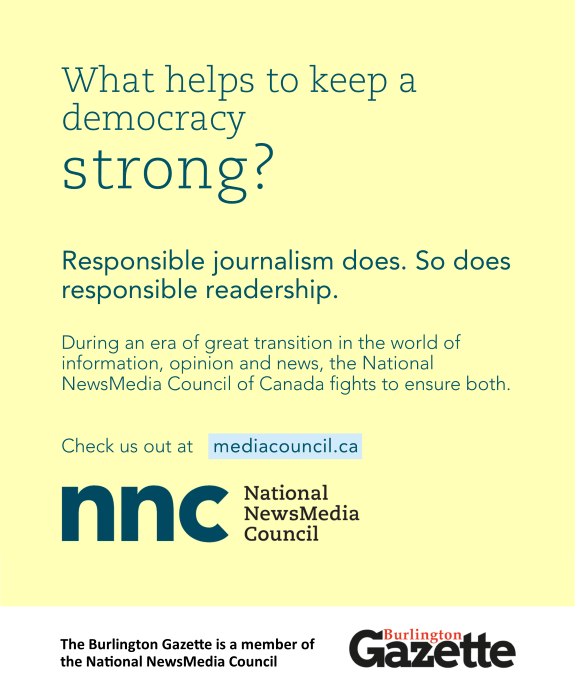 National Newsmedia Council advertisement that promotes the purpose of the Council. In the past several months there have been two complains made to the NNC about material published in the Gazette.
Both relate to the closing of two of the city’s seven high schools – and in each case the matter came from the Bateman community.
The fist was a complaint that we violated our privacy policy – which we in fact did. We published the name of an individual who has chosen a pen name rather than his own in a comment he made related to a Gazette article.
We later learned that the individual was a member of a Board of Education Advisory committee who we felt was hiding behind the pen name rather than letting readers of his comments know where his thinking was comment from.
We were asked by the NNC to apologize for braking our own rules which we did and that matter was closed.
Since then the Gazette has announced that it is in the process of changing its privacy policy; quite what form that policy change will take has not yet been determined.
We want to provide a form for people to air their views. We regret that frequently some people use a pen name and attempt to”game” the process. A number of news organizations have given up on a comments section. We are not prepared to go quite that far.
The second complaint is much more complex – it relates to a matter of fairness and just how much we did to ensure that we were fair and complete in our reporting.
The prime concern appears to be that we did not name the person we were reporting about but that anyone could read between the lines and determine who it was. Perception and reality are not the same thing.
 In our conversations with staff at the NNC they understand and appreciate that the closing of a high school is a very emotional issue and feelings come to the surface quickly. The situation at Bateman is very, very hard for many of the parents who have children in the Community Pathways Program to deal with. In our conversations with staff at the NNC they understand and appreciate that the closing of a high school is a very emotional issue and feelings come to the surface quickly. The situation at Bateman is very, very hard for many of the parents who have children in the Community Pathways Program to deal with.
We won’t comment further on this until the National Newsmedia Council has issued their decision, which we are advised will be before the end of the month. We hope at that time that we can name the individual, publish the content of the complaint and the Council decision which we will abide by.

The Burlington Gazette is a member of the National NewsMedia Council. This is the body in place to protect the public interest and ensure that media are fair, not always something that is easy to define.
Every quarter we get an update on what the association is doing and what other news media are up to.
We thought we would share what John Fraser, the president of the NNC, had to say.
Fraser has a rather impressive bio – he was the first North American reporter to be posted to China when he was with the Globe and Mail. He was also a former Master of Massey College. He is also a shameless punster; don’t let him get started.
 By John Fraser By John Fraser
April 6, 2017
BURLINGTON, ON
Opinion-mongering is one of the great bulwarks of traditional journalism. If you look at the history of newspapers, it will inevitably lead back to the glory days of London’s “Grub Street” periodicals and political broadsheets in the early 18th-century, generally favouring one party over another. Within a few decades, the business of music and theatre reviews also started up, either in their own broadsheets or attached to leading periodicals.
 There is, these days, a kind of return to these foundational roots in the rapid and happily unregulated rise of specialized digital journalism platforms. iPolitics, for example, has started asserting itself on the national consciousness as an important source of knowledge on our political and governmental life. Ditto for impressive digital-only publications like The Tyee; or some of the newest members of the NNC like Musical Toronto or Queen’s Park Today. They come about because there are readers who care about the things these platforms report and comment on and they want to stay informed. They also like the angle or perspective taken, and especially the sharp commentaries. There is, these days, a kind of return to these foundational roots in the rapid and happily unregulated rise of specialized digital journalism platforms. iPolitics, for example, has started asserting itself on the national consciousness as an important source of knowledge on our political and governmental life. Ditto for impressive digital-only publications like The Tyee; or some of the newest members of the NNC like Musical Toronto or Queen’s Park Today. They come about because there are readers who care about the things these platforms report and comment on and they want to stay informed. They also like the angle or perspective taken, and especially the sharp commentaries.
The diffusion is equally a challenge for readers as it is for an organization like ours which strives to offer a legitimate and independent service to deal with disputes or errors or misunderstandings, whether on a digital service or the printed page. It’s the misunderstandings about opinion mongering that I want to focus on in this issue of the NNC Newsletter. Columnists and reviewers often have strong opinions and strong opinions invariably arouse reactions, one way or another.
A big part of the NNC mandate and our day to day work is to explain to complaining members of the public the traditional role of critics and reviewers, whether in the arts, the legislature, or even the dining rooms of the nation. When an outraged bistro owner feels a food critic has been unfair in Toronto Life, or an angry patron of the Canadian Opera objects to a critical evaluation of a performance, or a political party member feels there is a particular bias in a column about his or her favourite public figure or issue, our team at the NCC spends a decent amount of time explaining the role of the columnist or critic. It is part of the service, you might say.
 John Fraser I am a former arts reviewer and former political commentator, so believe me I know exactly how exercised readers can get about opinion mongering. I often find myself explaining what I firmly believe is the matrix of a healthy political or performing arts life in any community and it usually involves engaging the public through reviews or commentaries that are studied in their provocation. If, on the other hand, a writer makes factual errors, it is a legitimate source of complaint with which we always deal very seriously. If it’s a matter of “he says, I say”, then we try to put it in the context of acceptable community standards and practice.
 John Fraser wrote an award winning book on his experience in China where he reported for the Globe and Mail. This usually works to the complainant’s satisfaction, but sometimes it doesn’t. In one such encounter we have had recently, we listened for an age (and several times) to a complaint about an editorial in a leading newspaper. The complainant was exercised by the fact that there were conflicting facts which emerged after an editorial had been published (a day later in fact). His solution was to ask the NNC to order the newspaper to add a note to the digital version of the editorial which said, in effect, “This was researched and written before counterbalancing facts emerged.”
We tried to explain that this was something that could be put on almost any article anyone published. The logic escaped him and he is probably still complaining to anyone who will listen that both the newspaper and the NNC lack 20-20 hindsight – or is it foresight? Hindsight, in fact, we have. Foresight is for unanswerable or unresolvable complaints.

 By Pepper Parr By Pepper Parr
December 29th, 2016
BURLINGTON, ON
Something is up!
 Burlington MP Karina Gould will be working New Year’s day. Burlington MP Karina Gould has called a media conference for Sunday January 1st at Tansley woods to announce what Burlington is going to get in terms of the Canada 150 fund projects.
Sunday media conferences are rare in this city – the federal Liberal’s jut might be directing their members across the country to hold these New Year’s Day events.
 Robert Stephen, President of the Art Gallery Burlington. President and CEO of the Art Gallery of Burlington, Robert Steven, and Peter Martin, President of Sound of Music are going to be part of the media conference which suggests there are some goodies for them.
The event will take place at noon New Year’s Day – it will be interesting to see just how much media the event gets.

 By Pepper Parr By Pepper Parr
November 4th, 2024
BURLINGTON, ON
So, it has come to this.
A once great newspaper gets sold to a wealthy businessman who keeps the presses running.
That is until his financial interests are threatened.
Jeff Bezos bought the Post for $250 million in 2013.
 To Jeff Bezos, the Post was a toy, it gave him some entrance, not that he needed it. For the most part, he kept his hands off the day-to-day operations, and kept an eye on how much he had to inject into the newspaper to keep it alive.
To Jeff Bezos, the Post was a toy, it gave him some entrance, not that he needed it.
Besides owning Amazon he had a number of high-tech interests, the biggest being Blue Origin, a private aerospace company that provides sub-orbital spaceflight services.
This is where the big, really big dollars were.
 There is hardly a household on the continent that isn’t impacted by his financial interests. It is reported that sometime this year, when Bezos was discussing Blue Origin contracts with federal-level bureaucrats, mention was made of a problem. ‘You have a Washington Post problem’ was the way it is reported to have been put to Bezos.
Traditionally American newspapers have endorsed candidates. The Post had an endorsement they intended to publish last week.
Bezos instructed senior editorial management not to publish an endorsement.
Executives from his aerospace company met with Donald Trump on the same day the newspaper prevented its editorial team from publishing an endorsement of his opponent in the US presidential election.
More than 250,000 readers cancelled their subscriptions; reported to be 20% of their circulation.
Peanuts to Bezos; another death knell to the newspaper publishing industry and another hammering of newspaper credibility.
 Democracy dies in Darkness The reports, editors and columnists all huffed and puffed but most were at their desks the next day.
What if the people who write the news and those who operate the presses banded together and published the newspaper? Make it a 16-page edition with nothing but the masthead on the front page. The rest would be blank – except for the advertising. Circulation for that day would have soared.
What a statement.
 Jeff Bezos Would Bezos have shut the paper down – would it have mattered if he did?
The Washington Post is dead – the credibility it had is gone – and in the process, they took another chunk out of the industry’s hide.
What will Jeff Bezos do should Kamala Harris become the next President of the United States?
The Post has a motto: Democracy dies in Darkness; indeed it does.
Salt with Pepper is an opinion column reflecting the observations and musings of the publisher of the Gazette, an on-line newspaper that is in its 12th year as a news source in Burlington and is a member of the National Newsmedia Council.

 By Pepper Parr By Pepper Parr
October 18th, 2024
BURLINGTON, ON
This is the third of a series on the changes taking place in print media and the challenge of keeping the public informed.
What is working well in the new media environment?
With next to nothing available in the way of printed newspapers in the vast majority of communities in Canada we began to see the emergence of online newspapers.
At this point the following are the daily newspapers in Canada: Calgary Herald, Edmonton Journal , Globe & Mail , Halifax Daily News , Montreal Gazette, National Post, Ottawa Citizen, Toronto Star , Vancouver Sun. The Halifax newspaper market is in a state of flux.
 Small independent newspapers found they could no longer survive – the cost of printing a paper was something that couldn’t be covered with what there was in the way of advertising revenue. Small independent newspapers found they could no longer survive – the cost of printing a paper was something that couldn’t be covered with what there was in the way of advertising revenue.
 Once a stable of 70 weekly newspapers. The Metroland Media Group had a stable of 70 weekly newspapers, one of which was the Burlington Post – at one time they published twice a week. In September of 2023 they abruptly shut down the papers and worked their way to becoming online newspapers. Metroland was a subsidiary of the Toronto Star that was seeking creditor protection at the time.
The Burlington Gazette was the first online newspaper that was admitted into membership in what was then the Ontario Press Council – that was in 2012.
Since then there are perhaps as many as 500 on line newspapers.
Online costs were lower which meant advertising prices could be lower.
However, publishers found that many of the retailers in the small markets didn’t understand digital – they didn’t have a clue as to how they could take advantage of the immediacy of an online paper.
The online publishers had to find ways to educate their potential advertisers and teach them the benefits of being online. Their editorial teams also had to learn how to work with a 24/7 news cycle.
Classified advertising was gone and national advertising had no place to go.
By national advertising, we mean advertising done by the auto section that looks for full page full colour advertising that used to run in every city across the country. Banks and insurance plus major brands were huge national advertisers.
What we began to see was the emergence of corporations that had online papers in many communities – the biggest example at this point is Village Media that has dozens of on line newspapers.
 Village Media – a collection of online newspapers that exists coast to coast. Village Media owns and operates local news sites in a number of markets and provides technology, consulting and fulfillment services to strategic news media partners. Together, they work as a collaborative partner network, with shared technology, ideas, content and advertising potential.
They also have an online broadcast that has a paywall.
They are funded by their advertising base.
 The Narwhal – a not for profit that has led the way in showing what online media can do when they joint venture with major daily newspapers. Another example of the new approach is The Narwhal – a not for profit that was able to secure funding from three different foundations to get started. They have a loyal following that donates on a regular basis.
What has made The Narwhal the success it is, was joining forces with the Toronto Star and now the Guardian, a British newspaper that went on line in 1999.
The Guardian has since established office in Washington DC and is proving to be a strong online competitor to the New York Times and the Washington Post. By March of 2001 the online Guardian has 2.4 million unique readers.
In the joint ventures with Toronto Star and the Guardian, the Narwhal editorial people would do the on the ground investigative work with editorial input and guidance from the larger media which would then publish the articles.
We believe that the larger media provided financial as well as editorial support.
 The editorial leadership at The Narwhal is for the most part female – a welcome change in the way newsrooms were once male dominated. The Narwhal’s leadership is female – not all but most of the leadership is female. Newspapers have in the past been a male dominated business. That has changed – for the better.
They are relentless with their drive to get subscribers that donate on a regular basis.
There is another small group Compass Newspapers. They developed a curated news application designed to deliver trending news. The company’s curated news application is for millennials, powered by an AI editor, and is able to choose the global politics, current affairs, business, finance, technology, and entertainment news published every day.
The use of Alternative Intelligence allows Compass to summarize and analyze their content giving their readers the latest news instantly.
This isn’t reporting – this is collecting what others have reported and packaging it based on the profile of their users. What surprised me was the support iPolitics gives them.
 For online newspapers the focus was getting the news out in a 24/7 environment; accounting and administrative stuff got a lick and a promise. The federal government has worked hard with media organizations to force Meta and Facebook to put some of their revenue into a fund that is distributed to media that meet the criteria; one of which submitting a corporate tax returns to Canada Revenue Agency. Many of the smaller online operations haven’t grown to the point where they can file a tax returns – their accounting system is a collection of receipts in a show box.
The Halifax Examiner, an on line paper is a subscription based operation. You pay a monthly fee ($12.50 a month) and you can read everything. They are doing very well.
We are seeing some consolidation of community based online newspapers – Village Media is one example. There are foundation supported online newspapers. The philanthropic sector is being approached by many for ongoing financial support
Part 1 New media replacing print with digital
Part 2 The change was taking place and we didn’t see it coming
Coming: What role are governments going to play in keeping media alive?

 By Pepper Parr By Pepper Parr
October 8th, 2024
BURLINGTON, ON
Second of a week long series on the changes taking place in print media and the challenge keeping the public informed.
In the period leading up to 2000 media found itself facing realty difficult times.
When Y2k (remember that event) was upon us no one really knew what was going to happen when we moved into the new millennium.
 Newspapers were selling their printing presses and contracting the work out. Media covered the event like a wet blanket – there were those that said it wasn’t really a problem while others suggested the machines that drive production would come to an immediate halt.
Media did a lot of reporting – but they didn’t pause to ask: what does this mean to us as an industry?
I don’t recall reading about any industry wide workshops; I don’t recall seeing anything in the way of op-ed pieces on what the industry needed to do in the way of changes.
Media covered disruption – without realizing that they were in line for some major disruption to their industry and they weren’t prepared.
The industry no longer had the aura of Watergate or the Pentagon Papers that made reporters heros – at that time thousands flooded into the industry wanting to be reporters. Reporters Bob Woodward and Carl Bernstein were the subject of close to fawning news stories, television specials and movies.
By the late 1980s journalism schools were being closed. The number of students that graduated got smaller and smaller.
The age of the men and woman in the news rooms was made up of people in their late 40’s and 50’s – there was no new blood coming into the industry. And there were few MBAs on staff of the large newspapers.
Those that were public corporations had financial analysts looking at profits which were decent at the time – what those analysts didn’t see was that the boat was moving quickly toward a Niagara size waterfall.
When the disruption of the revenue sources began media didn’t have a Plan B – they watched is losses began to climb and subscriptions slowly slipped away.
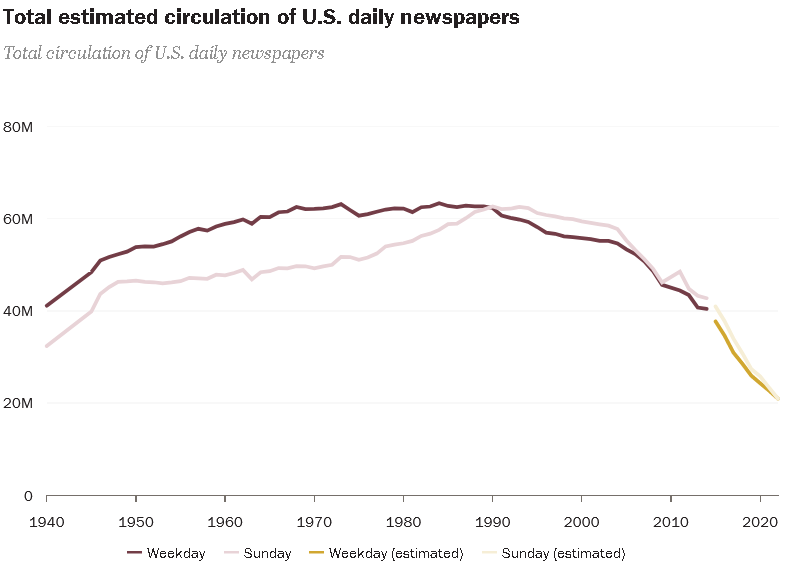 The data relates to American newspaper – the number will not be much different for Canada Part 1 of a week long series.

 By Staff By Staff
September 10th, 2024
BURLINGTON, ON
The following was taken from a CBC broadcast of an interview with Dominic Cardy, the leader of a new federal political party – the Canadian Future Party that is pitching itself as a centrist alternative to what we now have. The interim party leader says they are looking to fill a gap Canadians are looking for
“We’ve moved away from a policy and tone of moderation and keen judgment and civility, and when I speak with Canadians, said Cardy. “People say they’d like to see more of that. So we do think that we are helping to fill a vacuum that exists.
CBC: So give me the elevator pitch. What’s the Canadian Future Party all about? And why are you launching this now?
 Domenic Cardy was very active in New Brunswick. Cardy: “We want Canada to go, not left, not right, but forward. We think it’s time for a policy politics that’s focused on being brave, being evidence based, and delivering results, because if democracy doesn’t deliver then people are going to lose faith in it.
“We’re seeing that right now with the Liberals who are trapped in the politics of the 1990s and Mr. Poilievre, who perhaps is trapped in the politics of the 1930s – we want to talk about Canada moving ahead with clear, decisive plans for dealing with some of the big challenges that bluntly, Mr. Poilievre and Mr. Trudeau are simply not being honest with Canadians about wanting defence, immigration, housing and so on.
CBC: “I want to get to Mr. Poilievre in a second. Let’s give you a chance to kind of spell out what you’re all about. As you know, with the established party brands, people kind of have a vague idea of what they’re going to get right. With the Liberals, you’re going to get socially progressive, a bigger government. The Conservatives kind of anti-tax, tough on crime, smaller government. The Green Party, obviously, quite self-explanatory. What are some of the key foundational principles of the Canadian Future Party. What is your brand?
Cardy: “So we line up with the 70% or so of Canadians who say they see themselves in the middle and have concerns about the slide of the liberal and conservative parties towards the extremes. So we’re a party that is liberal on social questions and responsible when it comes to fiscal issues, because if we don’t have a government that delivers results, which means it has to be well run.
“People lose faith in it. And when people lose faith in their government, they look for alternatives. And I think one of the best ways to sum it up is, let’s look at the immigration crisis. Mr. Trudeau team created a political crisis by seizing political control of the temporary foreign workers and student visa programs. The other parts of the immigration system continue to work just fine. The crisis has come because the Liberals ignored the gatekeepers.
 Cardy: “We believe in expertise…” “So when Mr. Poilievre talks about getting rid of gatekeepers, we’re talking about duplicating triplicating, quadruplicating, the sort of crisis we’ve seen in immigration. We believe in expertise, but we believe that the experts have to show again that they can deliver, and we haven’t done a good job in the political elite of doing that over the last number of years.
“If we can’t get back to a government that actually shows results for Canadian citizens, we’re going to see that slide towards populism, which is exactly what Mr. Poilievre is taking advantage of. But at the same time, there’s a lot of people who don’t feel comfortable with his slide towards extremism and want to see a change from Mr. Trudeau, and we’re there to offer a sensible, evidence based solutions, set of solutions that we hope will attract attention from Canadians, and we’ll get to work on pushing that starting today.
CBC: “You’re a former provincial Progressive Conservative. The party’s interim president Tara McPhail says she’s a former conservative as well. Is this movement that you’re creating that you’re launching today? Is it a direct backlash against sort of the right wing, more populist style that Pierre Poilievre has adopted? You mentioned, you said it’s from the 1930s – maybe elaborate on that, and maybe speak to what his role was really in the formation of this party.
Cardy: “It’s not just Mr. Pollievre, and it’s not just the Conservative Party, it’s our politics writ large. The Liberal party is falling into the same trap, the falling into social media driven, algorithm driven extremism, appealing to people who are further and further away from the mainstream, further and further away from offering concrete solutions to real problems.
“ I don’t want to hear any more apologies for things that Canada has done wrong in the past. I want to see solutions to what’s wrong with Canada now. Mr. Poilievre spends his time talking about Canada being broken. Canada is a fantastic country. We’re not broken. There’s no end to what we can do. But we have people who’ve come to join the new party who are former members of Stephen Harper’s cabinet, former members of Jack Layton’s team: elected folks who are sitting in the House of Commons, former Liberal organizers, Greens, New Democrats, people from across the political spectrum who are all united: there’s something seriously wrong with our politics, that this approach of just using social media and leaders offices to run political parties divorced from MPS being given any real power to express their opinions and vote the way they feel they should in the House of Commons.
 I was a Cabinet Minister in New Brunswick from 2018 to 2020. “This is a problem that all the parties share, and it’s one where to use that example. We’re proposing a concrete change. Canada copied the British parliamentary system when we built this country. One thing we didn’t copy was the caucus system that allows back bench MPs in the UK to vote against their leaders if the Leader’s office can’t convince them to support them. In Canada, we treat our MPs like sheep. They just vote yay, yay, yay, nay, nay, nay, depending on what the leader says, there’s no reason we can’t change that. That takes will from political party leaders, and that’s what we’re here to say we’re going to do. And I have a record on this, that 2018 to 20 in New Brunswick, when I was a cabinet minister, I helped write the platform in 2018 we ran the government that way through the early stage of covid, creating an all party committee we got like a war cabinet to help manage the province during that crisis. That’s exactly the sort of creative approach we want to see brought to other crises facing Canada.
CBC: “We asked Poilievre spokesperson about your party, and this is what he told us, he said, quote, We are not paying much attention to what the former NDP leader says, and neither are Canadians. So obviously he’s referencing your past as NDP in New Brunswick, you were the leader of that party. Provincially. What do you say to them? It seems like they’re quite dismissive of you and your effort.
Cardy: “What we have seen, which you’ve probably noticed over the last couple of weeks, Mr. Poilievre claiming that his party is the centrist party. Tory influencers online trying to pass that same message. They see the same polls we do. They know that there’s a lot of Canadians, a majority of Canadians, who want to see a change, who are tired of Mr. Trudeau over promising and under delivering, but at the same time are really concerned about Mr. Pollievre’s drift towards populist extremism. So we’re here to offer an alternative to that. And so of course, they’re going to say insulting things. You know, of the other things we’re not going to do, get into that sort of gutter pop sort of gutter politics, we want to focus on what we’re going to do differently. Sure, we’ll be sharp when we have to be, but things like that are exactly why we need to change.
 Cardy: “I’d say it’s extremely dangerous.” CBC: “You say populist extremism, but it seems to have an appeal, right? I mean, he’s leading over the Liberals by 20 points in the polls. He’s at 43 points. You know, if we’re to believe the aggregators, that’s a huge lead. He’s poised to form a massive majority government if election were held today. So that seems to have a lot of appeal among people, right? I mean, there might be, you might quibble with his tone and tenor, but it’s certainly resonating.
Cardy: “Well, first, wouldn’t quibble with it. I’d say it’s extremely dangerous. And one of the things I think we’ve got to listen to is the voices around the world who’ve had their experiences with radical, populist governments on the left and the right in recent years is how dangerous they are, how they don’t make life better for people. So putting that aside, absolutely, he’s doing well, because right now his party is the only one that’s seen as an alternative to Mr. Trudeau. The NDP have hooked themselves, possibly permanently to the Liberals, certainly for the next election, they’re going to be judged on the same criteria that Mr. Trudeau team will be. The Greens, I think, have broadly succeeded to convince Canadians that climate change is real. Certainly, that’s not something we’re going to waste time on. In the Canadian future party, we believe climate change is real, then you’ve got Mr. Bernier party, who are just grumpy that they’ve been out ring out right wing extremists by Mr. Poilievre.
CBC: ” You mentioned the Green Party, as you know, in our first past the post system, it’s really tough for smaller parties to actually win a seat. It took the Green Party 30 years from their foundation to when they actually won a seat with Elizabeth May. What makes the Canadian future party different? How can you actually win a seat in a system that really does not advantage upstart parties like yours.
Cardy: “First that’s absolutely the case. We recognize the challenge we’re facing, and we’re only embarking on this project the people around me, who, again, come from all parties and none, who recognize the crisis Canada is facing. The reason why we’re doing this is because we want to offer Canadians that alternative, and Canadians have a choice going into the next election about whether they like that or not. Our job is to present a positive, well thought out platform and a team of candidates who could manage Canada.
CBC: “You mentioned candidates you’ve you’ve named at least one for the upcoming federal by election in Quebec and La Salle Marg you will name one in Manitoba as well. What is success look like? What are you expecting to see in those by elections?
 Cardy: “We’re going to be there with a team as new and fresh a party. It’s up to Canadians to decide.” Cardy: “In those by elections, we want to get our name out there and start to share our vision for Canadian Canadian politics longer term, our goal is to try and win as many seats as possible. I’ve never understood some folks in politics is how we’re just here to try and influence the other guys. In my time in the NDP, that was often a problem. So we want to try and win, but what we really want to try and do is change Canadian politics. I don’t care about party labels. If the liberals or Tories take all of our platform ideas and start recruiting people who believe in those same sort of mainstream, moderate values that most Canadians share. All power to them. If they don’t, we’re going to be there with a team as new and fresh a party as we might be to offer them that alternative, and we’ll see whether or not that catches fire. It’s up to Canadians to decide. That’s democracy.
CBC: “All right, let’s leave it there. Dominic Cardy is the interim leader of the Canadian Future party.
Deeper dive on Dominic Cardy
Dominic William Cardy MLA (born 25 July 1970) is a Canadian politician and Member of the Legislative Assembly of New Brunswick. From the 2018 New Brunswick general election until his expulsion from the caucus in October 2022, Cardy represented the electoral district of Fredericton West-Hanwell for the Progressive Conservative Party of New Brunswick. He now sits as an independent. During his time in government he was the Minister of Education and Early Childhood Development under Blaine Higgs. Since September 2023, Cardy has been the interim leader of the Canadian Future Party, a newly-formed moderate centrist federal political party. Prior to being elected to the New Brunswick legislature, Cardy served as chief of staff of the Progressive Conservative Party of New Brunswick caucus and had previously been leader of the New Brunswick New Democratic Party from 2011 to 2017.
Cardy resigned as party leader, as well as resigning his membership of both the federal and New Brunswick NDP, on 1 January 2017, complaining of party infighting which he attributed to “destructive forces” colluding with CUPE New Brunswick, the province’s largest public-sector union against his leadership. Cardy said that he “cannot lead a party where a tiny minority of well-connected members refuse to accept the democratic will of the membership.” He added that “[l]imited time and energy is being wasted on infighting before the election,” and that “‘Some New Democrats unfortunately believe change and openness have had their time. They want to return to an old NDP of true believers, ideological litmus tests and moral victories.”[ Cardy claimed that what he described as his “progressive” platform had been thwarted by both federal and provincial party members and denounced the federal party’s non-interventionist stance on the Syrian Civil War as antithetical to his beliefs.
Cardy’s appointment as strategic issues director for the opposition Progressive Conservative Party of New Brunswick was announced by party leader Blaine Higgs on 27 January 2017. Cardy said it is “not my intention” to run for a legislative seat as a Progressive Conservative candidate but that a “great many” of his former colleagues in the NDP would be joining the Progressive Conservatives.
In April 2017, Cardy was promoted to the position of chief of staff to the official opposition New Brunswick Progressive Conservative caucus. Later that month he endorsed Maxime Bernier for the leadership of the Conservative Party of Canada.
Cardy was elected in the 2018 provincial election as the PC candidate in Fredericton West-Hanwell. He had run unsuccessfully in 2014 in the same riding as a New Democrat.
Cardy was re-elected in the 2020 provincial election.
Cardy was appointed as Minister of Education and Early Childhood Development on 9 November 2018.Minister Cardy spearheaded a plan to remove the Confucius Institute from all New Brunswick schools. While the educational programs for elementary and middle schools were removed for the 2019–2020 school year, high school programs will not be removed until 2022.Cardy resigned from his position as Minister of Education and Early Childhood Education on October 13, 2022. Announcing his resignation on Twitter, Cardy explained that “At some point, working style and values have to matter.” His resignation letter offered a more detailed explanation, citing Premier Higgs’ behaviour in a series of incidents. Cardy initially committed to staying on as a Progressive Conservative but was expelled from caucus a day after resigning as minister. He was replaced as minister by Bill Hogan.Cardy remained in the legislature as an independent MLA for the rest of his term, while announcing he would not be running as a candidate in the 2024 New Brunswick general election.Cardy said he would be voting for Susan Holt and the New Brunswick Liberal Party in the upcoming election in June 2024. On September 20, 2023, Cardy announced that he was in the process of founding a new federal political party, named the Canadian Future Party to occupy the middle ground between the Justin Trudeau-led Liberal Party of Canada and the Pierre Poilievre-led Conservative Party of Canada. Prior to its launch as a party, the group had been known first as “Centre Ice Conservatives” and then as “Centre Ice Canadians.” On July 22, 2024, Elections Canada recognized the Canadian Future Party as eligible for registration, pending it standing a candidate for election.In July 2024, Cardy was arrested in Toronto for disturbing the peace after engaging in a confrontation at a pro-Palestine protest. According to Cardy, he chanted “Free Palestine from Hamas”. Authorities stated that Cardy “behaved in a confrontational manner towards other protesters and did not follow police directions” to leave the area. He was released without charges.

 By Pepper Parr By Pepper Parr
August 31st, 2024
BURLINGTON, ON
HELP US SUPPORT HUNDREDS OF CHARITIES, A TOONIE AT A TIME is the way the Burlington Rotary explained the $2 Entrance Fee being collected at the 2024 Ribfest.

“As you may know, Canada’s Largest RibFest is Rotary Burlington Lakeshore’s most successful community event where all proceeds are donated to support health, hunger and humanity across charities close to home and around the world. In the last 25 years, we have been able to donate close to 5 MILLION dollars to charities such as Burlington Food Bank, Joseph Brant Hospital, The Carpenter Hospice, Canada Diabetes Association Summer Camp, CCAC Child Abuse Emergency Fund, Terry Fox, Food Banks Canada, Haloton (sic)Fresh Food Box, Community Living Burlington, Out of the Cold, The Lighthouse Homeless Shelter, Able Sail and many more.
“We couldn’t do this without all of the amazing support we receive from the community and thank you in advance for a record-breaking Rib Fest this year!”
Did Rotary clear this with the City administration – Spencer Smith is a public park – I don’t think anyone can just say I’m collecting money for a good cause..
We don’t recall hearing anything from Rotary about this new approach to collecting money from the public. It looks like people within Rotary thought it was a good idea and they just went right ahead and did it.
Nothing wrong with the idea – getting public support before is usually seen as a best practice.
Given the close to crisis situation every dollar should be going to the Food Banks.
Salt with Pepper is the musings, reflections and opinions of the publisher of the Burlington Gazette, an online newspaper that was formed in 2010 and is a member of the National Newsmedia Council.

 By Staff By Staff
August 16th, 2024
BURLINGTON, ON
Attracting people to your cultural event is not easy.
Social media is great – providing you know how to use it to your advantage.
There are people who can help.
 Registration link is show below. Culture Days Ontario wants you to take part in their Culture Days event. Tune in on Thursday, August 29th, at 2pm ET. And learn the marketing and media tips you need to get your audiences to take notice and action during Culture Days.
Media expert Mercedes Blackwood will share practical tips on planning and running marketing campaigns. As well as how to work with the Media to help gain widespread reach for your arts and culture events.
We will also be joined by Ontario Culture Days’ Partnerships & Programs Manager, Kaitlyn Patience. She will share tips on connecting with and involving your local community, partners, and collaborators in your event promotion efforts!
 Join us to learn more about how to use the free Culture Days marketing tools, templates and resources available to help you: Join us to learn more about how to use the free Culture Days marketing tools, templates and resources available to help you:
- Increase attendance to your events.
- Increase awareness of your organization, group, business, or artistic practice.
- Create lasting audience connections and build year-round engagement.
This session will be presented in English with English captions available. A recording with French captions will be available shortly after the event. If you have specific questions or requests you would like addressed, please email us at info@culturedays.ca
Be the first to know; stay connected with your regional offices for updates, opportunities, and all-things Culture Days:
Register

 By Staff By Staff
July 17th, 2024
BURLINGTON, ON
Flood Update for July 17
Burlington and surrounding areas have received a large amount of rain since July 15. Flooding has occurred in several areas throughout the city and as a result, Burlington is now in Level 2 Enhanced Monitoring response. The City is making progress on clearing blockages, repairing/cleaning roads, boulevards, and tree debris removals. City staff and contractors will be out cleaning up and clearing debris over the next several days or weeks.
Updated reports indicate that on July 15, approximately 65mm of rain fell in three hours with more rain coming later. Work is ongoing to confirm the total precipitation.
Residents who need power, shower facilities or a comfortable place to go can come to any City recreation facility during normal business hours.
The City is working very closely with community partners including Burlington Hydro, Halton Region, Halton Regional Police Services, Enbridge Gas and the Ministry of Transportation.
Please continue to use caution when travelling around the city. Avoid all waterways such as ponds, creeks, streams and culverts.
- Do not drive or walk on flooded roads.
- If you or someone else is in immediate danger, call 9-1-1.
- If you have flooding on private property, please call 3-1-1 for Halton Region response.
- If there is flooding on roads or public property, please call Service Burlington at 905-335-7777 or city@burlington.ca.
Residents are encouraged to subscribe to news alerts for extreme weather alerts, road closures and more at burlington.ca/subscribe and follow the City’s social media channels for the latest updates.
Current Road Closures
- Flatt Road from #266 to the west terminus
- Unsworth Avenue from Garden View to Sandcherry Drive
- Cavendish Drive, 100m east of Weybridge Court
Road closure updates will be posted on social media as well as through the newsfeed at burlington.ca/roadclosures.
Cavendish Drive
Cavendish Drive is experiencing significant flooding due to a blocked inlet and partially failed berm located on Highway 407 ETR property. 407 ETR staff are on site responding, and City staff have been in ongoing communication with 407 ETR, and the Ministry of Transportation, and are prepared to address any issues on City property.
First responders have recommended that those with flooded basements find alternate accommodations until the floodwaters recede. Information on short-term support has been provided.
Special Council Meeting
A special Council Meeting has been scheduled for Friday, July 19 at 9:30 a.m. A verbal update will be provided to council on the current situation, actions taken, next steps and resourcing.
Residents can come to the meeting at 426 Brant St. or can stream the meeting at burlington.ca/calendar.
Burlington is a city where people, nature and business thrive. Sign up to learn more about Burlington at burlington.ca/subscribe and follow @CityBurlington on social media.
Infrastructure Investments
Since 2014 the City of Burlington has invested $20M in stormwater infrastructure which has made a difference in our ability to handle storm water and reduce flooding. The City is committed to asset and infrastructure management, consistently increasing our investment in these areas to mitigate the impact of severe storms and flooding.
Mayor Marianne Meed Ward said: “We understand the concerns and uncertainties following this week’s flooding events. As someone personally affected by the flooding, I empathize deeply with the distress caused. City staff and all members of Council are continuing to work with the community to get answers to questions and provide supports as quickly as possible. We will reconvene on Friday, July 19 at a Special Council Meeting to discuss path forward and provide updates to the community. We are fully committed to addressing this emergency and ensuring the safety and well-being of our community.”
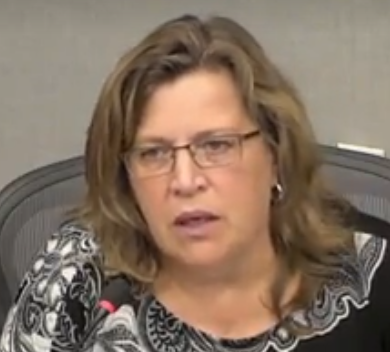 Councillor Stolte, along with Kearns and Sharman fully understood the gravity of the flooding. Stolte on the CURRENT STATE-July 17th, 2024 at 9:00 am
The Gazette received the email just after 2:00 pm.
The city activated the Emergency and Continuity Management team to address the flooding.
On Monday, July 15 and Tuesday, July 16, several rounds of extensive rain and thunderstorms resulted in flash flooding occurring in multiple locations across the region. Initial data suggests approximately 70 mm of rain fell on Monday, July 15, 2024 with the majority falling in isolated areas of the City of Burlington and Town of Oakville.
WHAT CAN RESIDENTS DO?
Residents should call Halton Region. They are continuing to update website and social media to provide the information. If you are experiencing basement flooding, the following are the key messages and steps to take:
1. Take immediate safety precautions
If you or someone is in immediate danger, please call 911.
Keep children and pets out of the affected area until cleanup has been completed.
If water has risen above electrical outlets or water is near electrical panels, consider shutting off your hydro. Contact your local hydro company and/or an electrician, if necessary. Note: This would affect the operation of a sump pump or sewage ejector.
If you detect gas, leave the house immediately and contact your gas provider. Water can extinguish a pilot light on a gas appliance, but gas may continue to run.
Do not use toilets or sinks until the source of the backup is known. This will help prevent more wastewater from entering your home.
Do not consume potentially contaminated food.
2. Contact Halton Region at 311 (24 hours a day, 7 days a week) or email accesshalton@halton.ca, regardless of the source of blockage.
Halton Region Public Works staff are working as quickly as possible to review the property history, discuss the situation with the property owner, and continue follow-up as required.
3. Contact your insurance provider to report damage and take pictures. Depending on the terms of the insurance policy, the insurer may:
-assign an adjuster to visit the impacted home to take additional pictures and handle the claim
-recommend a vendor who will conduct the emergency services and repairs
Please direct residents to our Taking Action – Wastewater (Sewage) Backups in Homes webpage for additional information, including how to safely clean and/or dispose of items and information regarding Halton Region’s ex-gratia grant. We are also keeping our channels updated with the latest information.
Once the current situation is resolved, we will be promoting prevention measures and our Enhanced Basement Flooding Prevention Subsidy Program to the community. This program makes it easier and more affordable for property owners to undertake improvements that can help reduce the risk of flooding.
WHAT IS THE CITY DOING?
The City’s Emergency and Continuity Management team was activated on July 15th. They continue to monitor the storm prediction centre and rainfall.
The city will continue to work with the Region on the matter and further discussion will occur.
The city’s Engineering Services team is sending out have inspection teams to take photos to track high water levels and damage. Design and Construction – Parks staff will be inspecting construction sites and parks to assess damage and repair damage as needed.
Roads Design and Construction – staff will also be assessing impacts and will be doing reporting on high water levels and damage assessment. Tyandaga Park was mentioned as having a lot of material has been moved from road construction sites.
Council has requested an update from staff on actions being taken. A special Council meeting was scheduled for Friday July 19th at 9:30am to get a status update on the City’s emergency response, and next steps. The live stream will be available at events.burlington.ca/meetings
ROAD CLOSURES?
Please be advised of the below road closures in effect due to localized flooding and extreme weather:
Flatt Road – # 266 to the end of the road
Unsworth Drive between Sandcherry Drive and Gardenview Drive
Cavendish Drive between # 2043 and # 2061
Ministry staff/City staff are working with Highway 407 property as it is has caused an overland flooding issue
Roads staff are doing street sweeping and cleaning throughout the city.
Guelph Line North of Dundas experienced a shoulder washout.
Related Gazette news stories:
Council stumbles its way to finding ways to keep the public informed.

|
|






















 John Best, a colleague who publishes the Bay Observer put it very well when he said: “Locally, the biggest danger is in a community like Burlington, where on a good day there would have been one or two people at the media table at City Council or Board of Education meetings—now maybe none.
John Best, a colleague who publishes the Bay Observer put it very well when he said: “Locally, the biggest danger is in a community like Burlington, where on a good day there would have been one or two people at the media table at City Council or Board of Education meetings—now maybe none. Metroland cited the challenging economic environment for newspapers – particularly the steep decline in print advertising revenue – for its financial troubles. The company’s papers have faced a “sizable loss of readership” and revenue has fallen more than 10 per cent each year for the past three years, according to Grant Thornton, an accounting firm.
Metroland cited the challenging economic environment for newspapers – particularly the steep decline in print advertising revenue – for its financial troubles. The company’s papers have faced a “sizable loss of readership” and revenue has fallen more than 10 per cent each year for the past three years, according to Grant Thornton, an accounting firm.


 Who is out there helping you understand what is happening?. Recall the people who spoke bluntly about the tax increase the city put in place? You would have read about their delegations in the Gazette
Who is out there helping you understand what is happening?. Recall the people who spoke bluntly about the tax increase the city put in place? You would have read about their delegations in the Gazette






 Eleanor McMahon, the Minister of Tourism, Culture and Sport was kicking off Public Library Week and announcing improvements to digital services at 307 libraries and library organizations across the province.
Eleanor McMahon, the Minister of Tourism, Culture and Sport was kicking off Public Library Week and announcing improvements to digital services at 307 libraries and library organizations across the province. McMahon told the small audience that Ontario is increasing access to technology, digital services and training opportunities at public libraries in towns, cities and Indigenous communities across the province. Funding is helping libraries offer more technology in their communities, such as wireless internet connections, new computers, and e-books, as well as classes on topics like social media and computer literacy.
McMahon told the small audience that Ontario is increasing access to technology, digital services and training opportunities at public libraries in towns, cities and Indigenous communities across the province. Funding is helping libraries offer more technology in their communities, such as wireless internet connections, new computers, and e-books, as well as classes on topics like social media and computer literacy. Ontario is investing $3 million through the Improving Library Digital Services fund to support up to 307 libraries and library organizations across the province. This includes $1 million for rural, remote and First Nation public libraries through 2017 Budget Talks. Burlington Public Library is receiving $25,000 from this fund.
Ontario is investing $3 million through the Improving Library Digital Services fund to support up to 307 libraries and library organizations across the province. This includes $1 million for rural, remote and First Nation public libraries through 2017 Budget Talks. Burlington Public Library is receiving $25,000 from this fund. The complainant stated that she was called by the Burlington Gazette for information related to a school closing, and in that conversation she stated the director of education met with the MPP about a school closing issue. The news media organization reported her information. Later the same day it ran a correction stating the meeting in question had not occurred, and that “false” information was knowingly given. The complainant alleged the inaccurate correction and accusation impugned her reputation as a writer. She provided wording for an amended correction.
The complainant stated that she was called by the Burlington Gazette for information related to a school closing, and in that conversation she stated the director of education met with the MPP about a school closing issue. The news media organization reported her information. Later the same day it ran a correction stating the meeting in question had not occurred, and that “false” information was knowingly given. The complainant alleged the inaccurate correction and accusation impugned her reputation as a writer. She provided wording for an amended correction.
 In our conversations with staff at the NNC they understand and appreciate that the closing of a high school is a very emotional issue and feelings come to the surface quickly. The situation at Bateman is very, very hard for many of the parents who have children in the Community Pathways Program to deal with.
In our conversations with staff at the NNC they understand and appreciate that the closing of a high school is a very emotional issue and feelings come to the surface quickly. The situation at Bateman is very, very hard for many of the parents who have children in the Community Pathways Program to deal with.






























